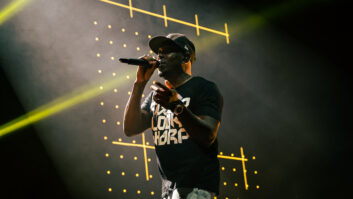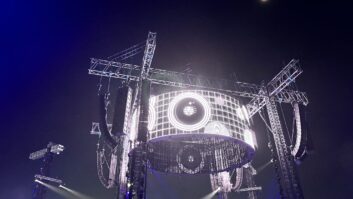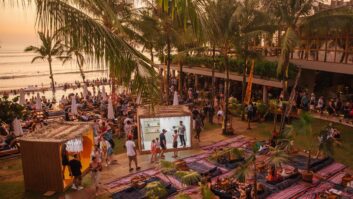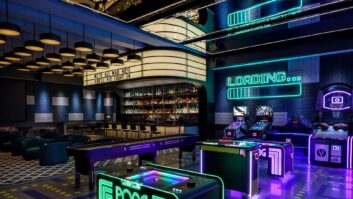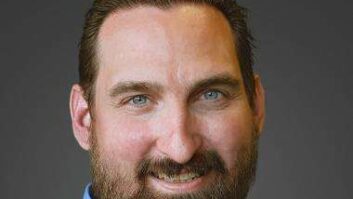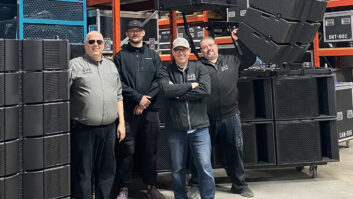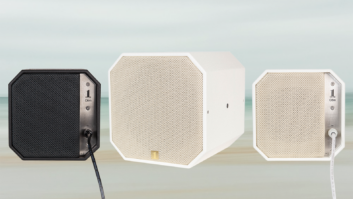Music festivals are an established phenomena in modern culture, but have changed in nature since the middle of the last century. The festival as we know it today has its roots in the jazz world, with Montreux, Newport and, latterly, Reading (before it went fully rock) setting the template for multiple acts on different stages over an extended period of days.
Back then they were few and far between, but after the youth explosion of Woodstock and Monterey, leading to the Isle of Wight and Glastonbury festivals in the UK, more music events sprang up, resulting in a defined festival season stretching over the summer into early autumn. In fact, Installation will be starting its on-site festival coverage – of pro audio and other AV tech deployed – in the Spring this year, with Shindig in Somerset; before hitting Glastonbury in June, and Secret Garden Party in July.
Pro audio technology has, of course, played a major role in the growth and popularity of festivals since their early days, but is now even more vital due to many more stages at each event offering a wide variety of musical styles.
SHUT DOWN
The entire live production sector was shut down during the earliest and worst days of the pandemic, but came back with a vengeance in 2022 throughout the UK, creating a full schedule on the festival circuit that has continued into this year.
“The number of events and festivals is on the rise again after the Covid hiatus and you will find that the amount of so-called large and mega-events is increasing rapidly,” comments Tom Vollmers, head of professional portfolio at Sennheiser. This situation has put pressure on PA rental stocks, something exacerbated by the component supply problems experienced by manufacturers, causing backlogs in the delivery of new equipment.
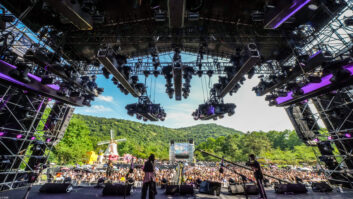 Another problem caused by the proliferation of festivals is the allocation of radio frequencies for wireless technology, specifically microphones and in-ear monitors (IEMs). “This puts frequency managers in a tight spot, especially with regard to outdoor events that do not have any protection from RF interference,” Vollmers explains. “As a result, there are already festivals where bands are unable to use their older equipment. To address this issue, it is crucial to adopt digital microphone systems that do not produce any significant inter-modulation and are therefore able to provide a frequency-efficient, equidistant frequency spacing.”
Another problem caused by the proliferation of festivals is the allocation of radio frequencies for wireless technology, specifically microphones and in-ear monitors (IEMs). “This puts frequency managers in a tight spot, especially with regard to outdoor events that do not have any protection from RF interference,” Vollmers explains. “As a result, there are already festivals where bands are unable to use their older equipment. To address this issue, it is crucial to adopt digital microphone systems that do not produce any significant inter-modulation and are therefore able to provide a frequency-efficient, equidistant frequency spacing.”
The dramatic reduction in available spectrum for the PMSE (programme makers and special events) sector, which relies on wireless microphones and IEM systems to make big live, outdoor productions work, has led to wireless system manufacturers producing RF efficient technologies that are more robust when it comes to interference, and provide redundancy to guard against failures. The implementation of digital processing has helped a great deal in this regard, with leading microphone brands introducing new systems in recent years. These include the Sennheiser Digital 6000, EW-DX, and EW-D and Shure’s Axient system, along with the new KSM8 vocal mic.
SHRINKING SPECTRUM
Stuart Moots, sales director for pro audio at Shure, acknowledges that spectrum for PMSE use is “shrinking”, particularly on festival sites where RF is in high demand not only for what happens on stage but also in the communications, rigging and lighting departments. “While not every festival is Glastonbury or Download, the requirements from the microphone, IEM and wireless system are the same: great audio and the expectation that it performs flawlessly every time,” he says. “Ultimately it depends on what the landscape for wireless looks like. That – and budget – will drive the decision on what is to be used.”
|
Moots adds that although both professional and consumer audio relies increasingly on cable-less connectivity, wired microphones still offer the same good quality audio and performance as their wireless counterparts.
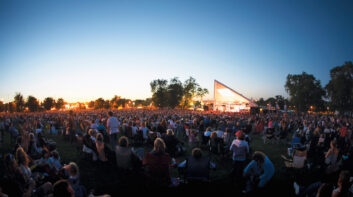
Sound engineer and tour manager Tim Boardman observes “normally, anything that doesn’t move we still use cabled microphones”, to avoid equipment failure. “If something is cabled, it just removes any kind of element of concern,” he explains. “It’s gently changing now in that wireless technology is so much more reliable than it used to be – but there was a period when you just wouldn’t trust any of your wireless gear and try to keep as little of it on stage as possible. And there was a time when people were trying to cram as much as they could into Channel 38, but I’m now at a point in my life where wireless frequencies aren’t so much of a problem.”
Both Boardman and Paul Bullimore, production manager with Bristol and Swindon-based rental company Amber Audio, see Sennheiser’s 2000 Series as one of the leading IEM systems currently in use. Among the festivals Amber provides equipment for are Shambala UK (on the Sankofa’s and The Enchanted Woods stages) and the long-standing, leading example of musical diversity, WOMAD (World of Music, Arts and Dance).
Bullimore comments that the mic selection for these and other productions is “pretty standard”, including the omni-present Shure SM58, plus the SM57 and the Beta versions of both mics, along with Sennheiser’s e 945 and e 935, beyerdynamic condensers and the AKG CK91 and 414.
He adds that he always works hard on the “advance side of things” to suit whatever a festival or an individual stage is doing. “Sankofa’s is an awesome stage,” he says. “The variety of musicianship it has is phenomenal. Last year there was someone playing an eight-metre long bass guitar with only two strings, although that wasn’t on my shift. You don’t get taught how to mic something like that at audio school. Generally we tend to go for the most stable and accurate mics. I’m a big fan of the CK91, which you can amplify comfortably in a live environment. Of course, it’s all about using the right mic for the job.”
ESTABLISHED FEATURE
A regular at Shambala is the Chai Wallahs touring venue, which is now an established feature on the UK festival scene. Sound gear for this is supplied by west London rental house H Pro Audio. Managing director and sound engineer Harry Bishop comments that self-contained stage IEM systems are now in vogue, with artists sometimes doing the mixing themselves.
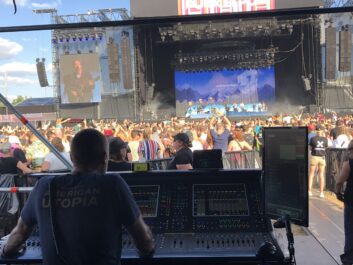 “Microphones and IEMs are ruled by the same companies – Shure, Sennheiser and AKG,” he adds. “Audio-Technica make some great mics, especially for the price, but they don’t feature on riders very often. KLANG:technologies and similar systems are becoming more common for IEM mixes. Another trend is for smaller control packages but with mixing desks in general, DiGiCo is king, but Allen & Heath is gaining popularity rapidly.”
“Microphones and IEMs are ruled by the same companies – Shure, Sennheiser and AKG,” he adds. “Audio-Technica make some great mics, especially for the price, but they don’t feature on riders very often. KLANG:technologies and similar systems are becoming more common for IEM mixes. Another trend is for smaller control packages but with mixing desks in general, DiGiCo is king, but Allen & Heath is gaining popularity rapidly.”
DiGiCo, Allen & Heath and KLANG are all members of the Audiotonix group of companies, which also includes Solid State Logic, Calrec and, most recently, Harrison. Maria Fiorellino, marketing manager at DiGiCo, says KLANG is now being specified by artists as part of the monitor set-up, while DiGiCo’s consoles will feature at major festivals this year, beginning with Coachella in California, running through the summer, including the Montreux Jazz Festival, up until September.
“We always work hard to build relationships with our user base and much of our development is influenced by market demands,” Fiorellino says. “We often hear, ‘Wouldn’t it be cool if your consoles did…’ and we act on that, building the tools engineers want and need. Beyond the obvious and almost constant request for more channels, we see the continued trend for in-the-box mixing. This is not something new and, with our industry becoming increasingly aware of its carbon footprint, the less gear a tour has to carry and the consequent need for less transportation, the better. Environmental impact increasingly plays an important part of our R&D process, which results in lighter, more power efficient, flexible and scalable products.”
CONTROL PACKAGES
When it comes to consoles and control packages, the trend, says Tim Boardman, is for bands to arrive at a festival with their preferred equipment. “Even at the low end, everyone is bringing their own gear now,” he comments. “On all of the major festivals, the opening act is carrying a control package. Two acts I work with, [singer-songwriter, guitarist] Griff and [alt metal band] Bring Me The Horizon, did the Reading and Leeds festivals last year and every single act on the main stages from 11am until midnight was using entirely their own equipment.”
To service this new requirement, Boardman says there has been a “proliferation of great bespoke companies” that put together systems to an artist’s specifications. These include Triplex Productions, which in 2021 was bought by Adlib, the UK’s biggest independent PA hire company, and Patchwork London. Boardman adds that in recent years the almost standard in-house console set-up at the big festivals, including Reading and Leeds, has been Yamaha CL5s on monitors and Avid VENUE | S6L front of house.
“Although more people are moving towards DiGiCo,” he comments. “For Bring Me The Horizon, it’s a DiGiCo on monitors and an Allen & Heath front of house. Solange Knowles is DiGiCo both ends or, if we can get hold of it, one of the large format S6Ls for front of house. Griff is something of an anomaly. Because of such a small touring group, we’re only six people on the road and our audio guy ends up running FOH from one console, the small format Allen & Heath dLive C1500, which has allowed us to do huge support shows and festivals with an amount of gear, also including lights and video, that can fit in a Transit van.”
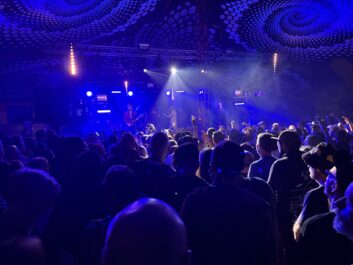 A relative newcomer to the roster of front of house and monitor boards is Lawo’s mc² range of consoles. Lawo is best known for broadcast desks, but its mixing systems are now being used for live sound as well. US rock band Phish is now touring with one, while rental giant Clair Global is beginning to add the mc² to its stock portfolio. In terms of festivals, Lawo has featured at the 2022 Bastille Day concert in Paris and at the Puccini Festival in Torre de Lago, Italy.
A relative newcomer to the roster of front of house and monitor boards is Lawo’s mc² range of consoles. Lawo is best known for broadcast desks, but its mixing systems are now being used for live sound as well. US rock band Phish is now touring with one, while rental giant Clair Global is beginning to add the mc² to its stock portfolio. In terms of festivals, Lawo has featured at the 2022 Bastille Day concert in Paris and at the Puccini Festival in Torre de Lago, Italy.
Massimiliano Salin, technical pre-sales and project manager for Lawo, acknowledges that at most festivals today, artists arrive with their own pre-set mixers and back lines. The situation is different in classical music, he says, where good quality consoles form part of the standard system for an event together with the loudspeaker rig and microphones.
“Some form of immersive audio is becoming increasingly important, however,” he observes. “This is used at the Ravenna Summer Festival of classic music, which is produced with Lawo mc²36 MkII consoles and d&b Soundscape by specialists BH audio, as well as at the Zurich Opera, the Bregenz Festival with their floating stage on Lake Constance and the Tomorrowland Festival in Belgium with mostly electronic music.”
Immersive audio does feature at WOMAD, with a dedicated d&b Soundscape tent, run by the SFL Group of Reading. Amber Audio has also provided a non-Soundscape d&b multi-channel system in another venue. In general, though, immersive sound systems are still rare on the live sound circuit, as James King, director of marketing at Martin Audio, observes: “We are not currently seeing immersive audio as a common requirement for festivals”.
FULLY IMMERSIVE
There are plenty of challenges with achieving a fully immersive environment within the practical considerations of a festival site. Firstly, there would be much higher cost implications for the organiser as a considerable amount of extra PA would need to be brought in and set up. There is also the artistic challenge of delivering an effective immersive show across the expansive space of a festival site. Finally, there is always the need to mitigate off site noise – this is even more of a challenge when you have a lot more PA to contend with.”
Noise abatement is, continues King, an important factor in designing a festival sound system, together with sound quality and reliability. It also needs to be versatile and cope with a variety of musical styles.
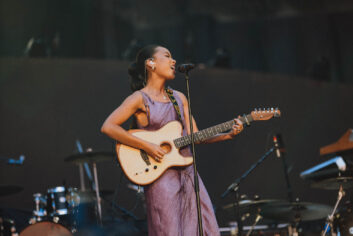 “A modern PA has to be suited to a range of music genres otherwise no rental company would be investing in it,” he says. “At a festival, the sound system design needs to be flexible enough to cater for all performers while also focused on delivering the best audio experience.”
“A modern PA has to be suited to a range of music genres otherwise no rental company would be investing in it,” he says. “At a festival, the sound system design needs to be flexible enough to cater for all performers while also focused on delivering the best audio experience.”
Martin’s MLA and Wavefront Precision are now used widely at festivals, including Glastonbury. The event’s audio consultant, Simon Honywill, specified W8L Longbow loudspeakers for the iconic Pyramid Stage in 2008; these were replaced by MLA in 2014. This year it will feature four hangs of 20 MLAs as the main system, 36 subs and eight delay positions in two rings made up of a combination of WPL large format and WPC compact line arrays.
“The design now being used was put together for the last Festival before the pandemic,” Honywill explains. “It works incredibly well. The levels that are achieved in the Pyramid field are in the low hundreds. In the past bands like Muse and The Killers have been absolutely banging, with no problems off site and no massive fines from the council.”
ECLECTIC MIX
Honywill also works on the West Holts Stage and two stages in Block9, which features DJs and electronic artists. “West Holts is a standard festival system,” he comments. “We put in a DiGiCo SD12 house monitor console and that gets used a lot. There are relatively few acts that bring their own control on that stage. It’s quite an eclectic mix of music that goes on there; everything from Jeff Goldblum and his jazz band to Billie Eilish before she was massively popular, with African acts and Japanese naked punk in between.”
While the Pyramid stage front-of-house area is big enough to accommodate around four guest consoles, Honywill says there is still the expectation that most artists will use the gear provided. “Whatever happens, and we’ve had various acts try to change this, the headliners will play through the Martin Audio system and it’s been universally really well accepted.
“For the control side of things, we put in a house rig, which is generally two SD12s flip-flopped front of house. The acts lower down the order are encouraged to use that and the monitor desks we provide. But we do quite a bit of pre-production so they can get want they need and build sessions on the SD12 beforehand. But the Festival has the philosophy that there is no single act that is bigger than the Festival.”
And certainly there seems to be nothing bigger than festivals on the music and tech scenes right now.
